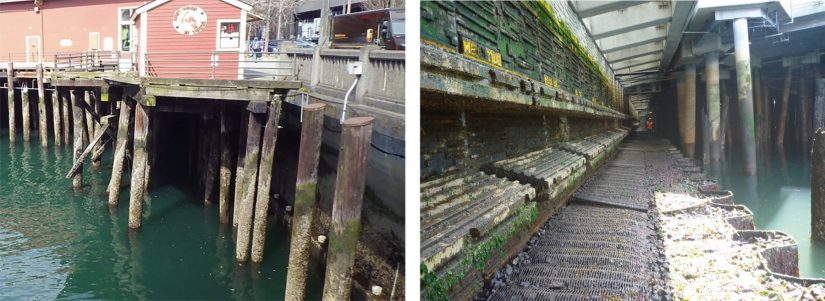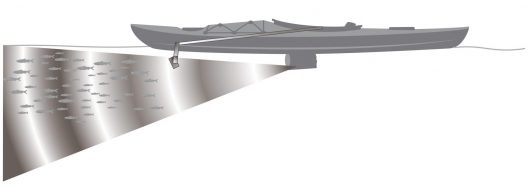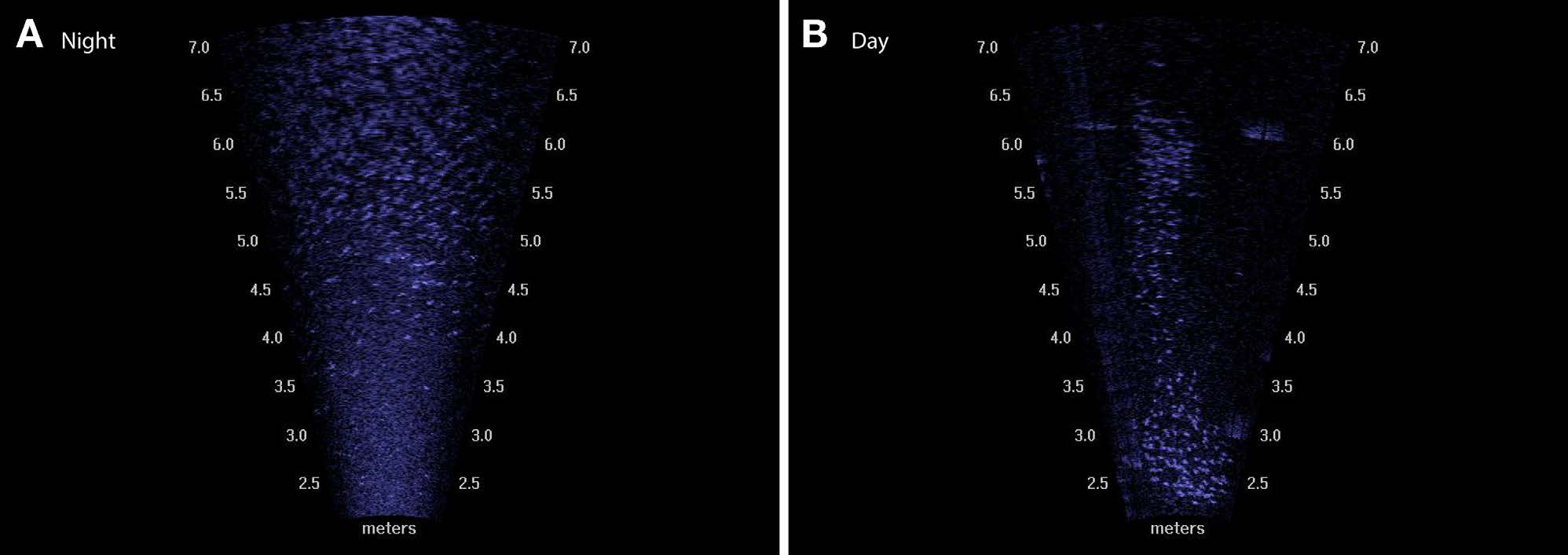Sound solutions for Seattle’s salmon
In 2001, the Nisqually earthquake damaged the integrity of the Elliott Bay seawall along Seattle’s waterfront. Sections of compromised seawall were replaced to form a new ecologically engineered corridor, consisting of intertidal benches to elevate the seafloor, textured seawall to provide refuge and encourage invertebrate colonization, and glass blocks on the above sidewalk to increase ambient light to mitigate habitat degradation and benefit salmon.
Juvenile salmon utilize shallow shoreline habitat for foraging and refuge from predators. Assessment of salmon populations along these revitalized structures has traditionally relied on visual observation methods, like snorkel surveys. Now, researchers are also turning to novel sonar applications to monitor fish from the surface.

identical location, shown at an uncommonly low tide (right). Kerry Accola
By mounting a specialized mobile sonar called a DIDSON (Dual-frequency IDentification SONar) under a kayak, UW research scientist Kerry Accola is able to count the juvenile salmon along the shoreline from the water’s surface. The sonar is capable of capturing high fidelity images during the day and also the night, when normal visibility is greatly reduced.
These new surveys provided salmon counts twice that of visual surveys and revealed behavioral details previously unknown to researchers. The presence of juvenile salmon at night was found to be twice that of the day, and counts were one-and-a-half times higher at night during times of high salmon concentrations. The study results were published as two companion papers in Marine Ecology Progress Series on January 20 and April 7.

Accola recalls that this new survey idea was a bit of a gamble at first. DIDSONs are generally placed in a static position in rivers and capture horizontal data as fish swim by. It wasn’t known how the additional variables of the moving kayak, shifting backgrounds, size of the fish, and marine debris would influence the sonar’s images. To her delight, the sonar performed better than expected; successfully producing high resolution images of juvenile salmon beneath the kayak.
“The images generated by the sonar are so high fidelity that it is close to looking at them optically,” said Accola. “You can’t see colors or the fins on them, but you really see that they are salmon.”
Her familiarity with the size, shape, and schooling behavior allowed Accola to correctly identify fish from the images. The relatively low biodiversity of fish along the seawall was also advantageous, although as the season went on, it became more challenging as other species began schooling in the study sites.
The researchers discovered that juvenile salmon are using the new eco-engineered corridor with much more frequency than old habitats like piers. Their findings show many salmon along the ends of piers early in the season before they move offshore, indicating they’re going around the pier, rather than beneath it.
“A lot of the salmon are still avoiding the area directly beneath the piers,” said Accola. “We found more salmon along old pier ends at night, meaning they’re migrating around those old ends when they don’t have access to the new corridor.”

Salmon were found in considerably higher numbers at night than during the day. Based on her observations, Accola hypothesizes that salmon are attracted to the artificial light emitted by the city.
Artificial light is known to negatively impact species and ecosystems. In Lake Washington, it was found that juvenile salmon experienced increased predation, as predators used the light to aid in hunting; the light also appeared to delay salmon migration. Ironically, Accola and the team believe the artificial light may be attracting the juvenile salmon to the nearshore at night, which includes the new corridor. Future research will continue to monitor salmon at night to determine if they are also using the light to find food.
This research was conducted throughout 2019 and primarily identified chum and Chinook salmon. The various species of Pacific salmon have a wide range of migration patterns and behaviors, highlighting the need for annual studies. The team is planning to continue to monitor Seattle’s seawall restoration in order to gain insight on how to improve local salmon populations.
Coauthors include John Horne, professor at the University of Washington School of Aquatic and Fishery Sciences (UW SAFS), along with Jeffery Cordell and Jason Toft of the Wetland Ecosystem Team also at UW SAFS. This research was funded by Washington Sea Grant, with a matching contribution from the Seattle Department of Transportation.
For more information, contact Kerry Accola.